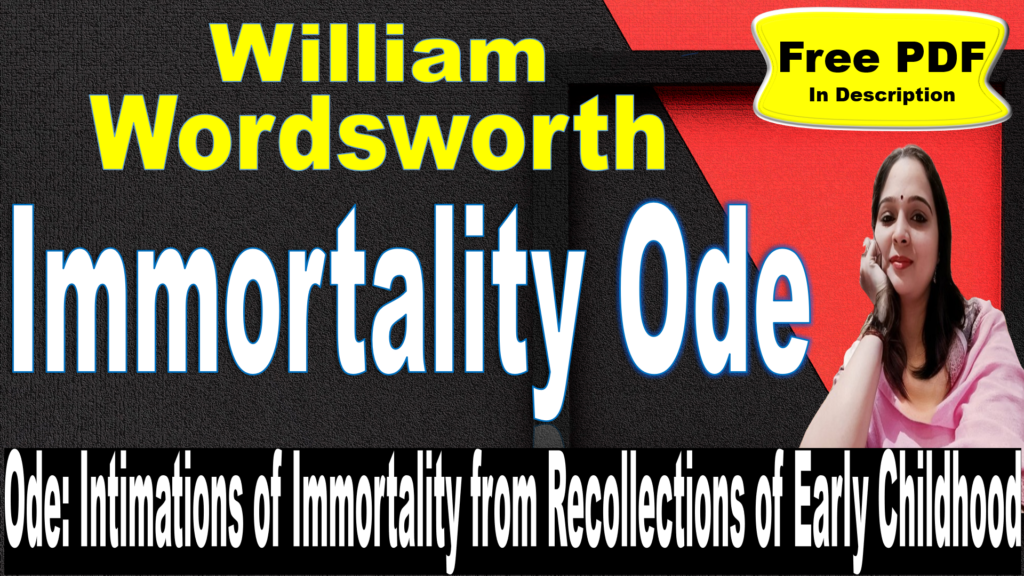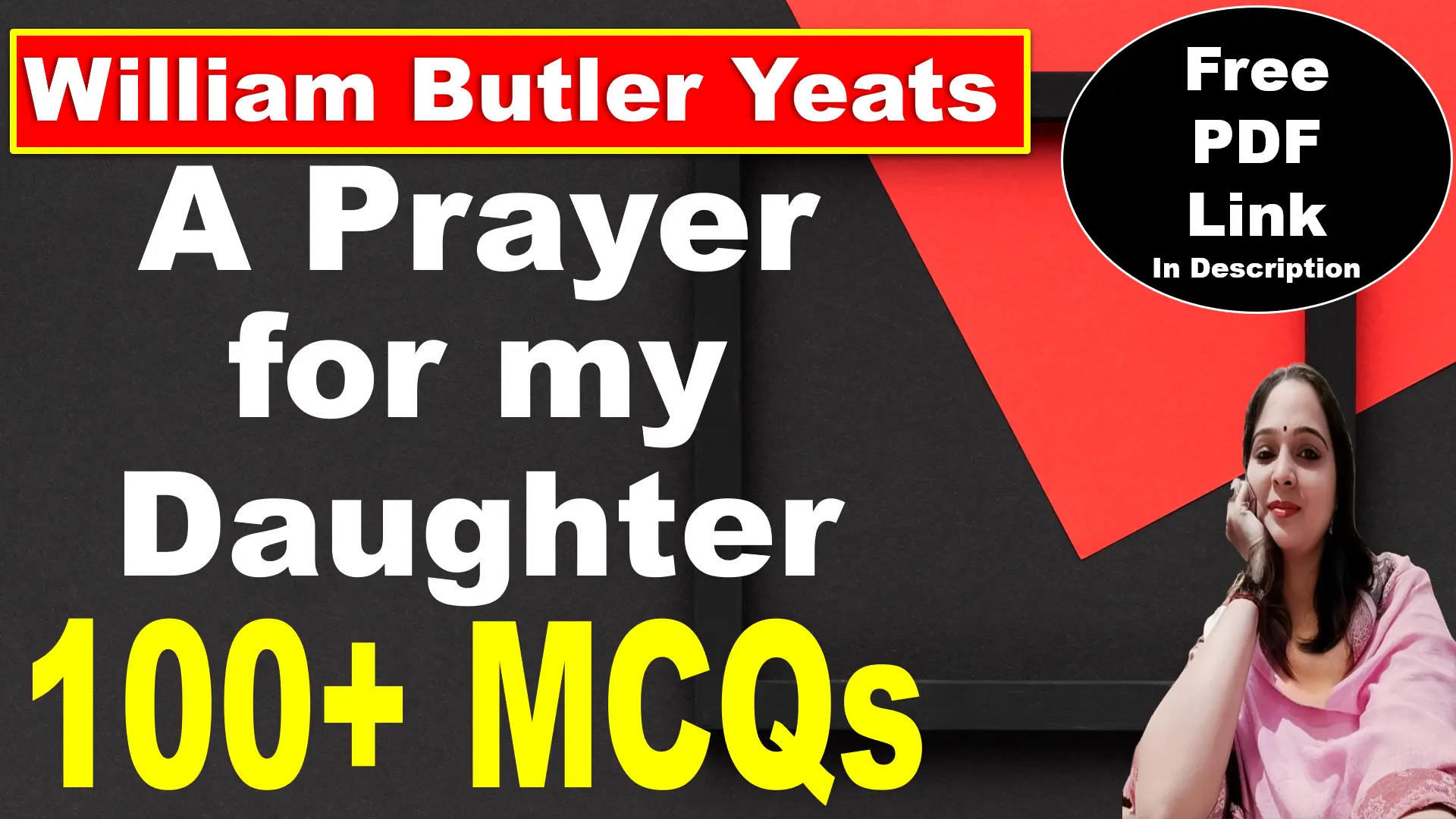
Immortality Ode: Questions and Answers
Very Short Answer Questions
Q: Who is the author of the poem?
A: William Wordsworth.
Q: What type of poem is “Ode: Intimations of Immortality”?
A: It is an ode.
Q: What is the primary theme of the poem?
A: The loss of childhood joy and its enduring impact.
Q: Which natural elements are frequently mentioned in the poem?
A: Meadows, hills, streams, and brooks.
Q: What does the speaker reflect on in the poem?
A: The loss of childhood wonder and the comfort found in nature.
Q: How does the speaker describe childhood experiences?
A: As filled with celestial light and glory.
Q: What does the poem suggest about the continuity of childhood joy?
A: It suggests that childhood joy continues to influence us throughout life.
Q: How does Wordsworth describe the effect of age on perception?
A: Age dims the sense of wonder and beauty once felt.
Q: What is the rhyme scheme of the poem?
A: It varies.
Q: What does the speaker find solace in despite the loss?
A: In the enduring beauty of nature and childhood memories.
Q: What metaphor does the poem use to describe childhood joy?
A: Trailing clouds of glory.
Q: How does the poem depict the role of nature?
A: As a keeper of childhood memories and a source of comfort.
Q: What does the speaker compare the fading childhood joy to?
A: A glory that has passed away from the earth.
Q: How does Wordsworth describe the landscape in the poem?
A: Vibrant and full of natural beauty.
Q: What emotion predominates in the speaker’s reflection?
A: Nostalgia.
Q: How does the poem address the passage of time?
A: It acknowledges that time changes our perception of joy and wonder.
Q: What does the speaker believe about childhood and nature?
A: Childhood and nature are interconnected and spiritually significant.
Q: What role does “philosophic mind” play in the poem?
A: It represents the deeper understanding gained with age.
Q: What imagery is used to evoke childhood experiences?
A: Imagery of bright days, blooming flowers, and joyous play.
Q: How does the poem describe the effect of nature on the speaker?
A: It provides comfort and a connection to the past.
Q: What does the poem suggest about human suffering?
A: It suggests that soothing thoughts can emerge from human suffering.
Q: How is the concept of immortality addressed in the poem?
A: It is linked to the enduring essence of childhood experiences.
Q: What does the poem say about the role of the human heart?
A: It is crucial for experiencing and remembering joy.
Q: How does Wordsworth feel about the “meanest flower”?
A: He finds deep significance and joy in even the simplest aspects of nature.
Q: What is the tone of the poem?
A: Reflective, nostalgic, and hopeful.
Q: How does the poem describe the transition from childhood to adulthood?
A: It is seen as a loss of visionary and joyful experiences.
Q: What does the speaker feel has been lost over time?
A: The immediate and intense joy of childhood.
Q: How does Wordsworth view the role of childhood in later life?
A: As a source of inspiration and enduring spiritual insight.
Q: What is the speaker’s attitude towards the fading of childhood wonder?
A: He accepts it with a sense of melancholy but finds solace in nature.
Q: How does the poem end?
A: It ends on a hopeful note, finding beauty and joy in nature despite the passage of time.
Short Answer Questions
What is the central theme of the poem?
The central theme of the poem is the idea of immortality and the transient nature of human experience. Wordsworth reflects on how the sense of divine or spiritual glory, which is vivid in childhood, fades as one grows older. The poem explores how memories of this childhood bliss continue to offer solace and insight throughout life.
How does Wordsworth describe the process of growing up in the poem?
Wordsworth describes growing up as a process of losing the direct connection with the divine and eternal. He illustrates how the spiritual and joyful experiences of childhood diminish as one matures, replaced by a more mundane and practical outlook on life.
What role do nature and natural imagery play in the poem?
Nature and natural imagery play a significant role in the poem, serving as symbols of the divine and eternal. Wordsworth uses images of meadows, hills, and streams to evoke the beauty and spiritual essence that he feels are diminished with age. Nature reflects the purity and glory that he associates with childhood.
Explain the use of contrast between childhood and adulthood in the poem.
The poem contrasts childhood with adulthood to highlight the loss of spiritual insight and joy as one ages. Childhood is portrayed as a time of natural connection with divine glory, while adulthood is depicted as a period where this connection fades, replaced by the burdens and limitations of practical life.
What does Wordsworth mean by “trailing clouds of glory” in the poem?
“Trailing clouds of glory” refers to the idea that children come into the world with a residual sense of divine light and spiritual presence. Wordsworth suggests that this innate spiritual awareness is a remnant of a pre-birth existence in a heavenly realm, which gradually fades as the child grows older.
How does the poet view the concept of memory in relation to childhood experiences?
Wordsworth views memory as a vital connection to the spiritual experiences of childhood. He believes that memories of childhood joy and wonder continue to provide comfort and insight throughout life, helping to sustain a sense of spiritual fulfilment despite the loss of direct connection with that glory.
What is the significance of the imagery of “splendour in the grass” and “glory in the flower”?
The imagery of “splendour in the grass” and “glory in the flower” signifies the beauty and divinity that Wordsworth associates with childhood. These images evoke the sense of natural and spiritual wonder that he feels is lost as one grows older, symbolizing the fleeting nature of pure, untainted joy.
Discuss the poet’s attitude toward aging and the passage of time.
Wordsworth’s attitude toward aging and the passage of time is reflective and somewhat melancholic. He acknowledges that aging brings a loss of the direct spiritual experiences of childhood but also recognizes that the memories of these experiences provide enduring solace and insight.
How does Wordsworth use the motif of “light” throughout the poem?
Wordsworth uses the motif of “light” to symbolize spiritual illumination and divine presence. In childhood, light represents the innate sense of glory and spiritual insight. As one ages, the light fades, but memories of that light continue to offer guidance and comfort.
What message does Wordsworth convey about the relationship between childhood and adulthood?
Wordsworth conveys that while childhood offers a direct connection to divine and spiritual experiences, adulthood brings a more practical and mundane perspective. However, the memories of childhood’s spiritual clarity and joy continue to influence and uplift individuals, providing a sense of continuity and hope amid the challenges of adult life.





